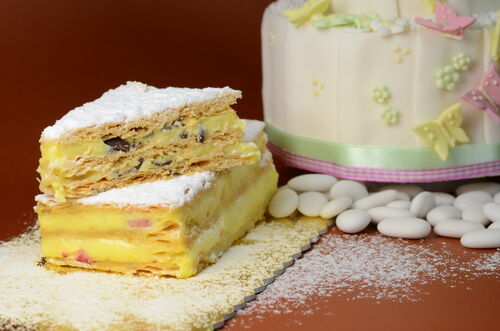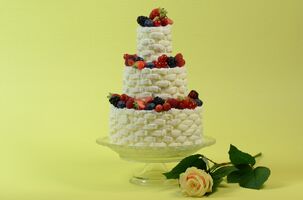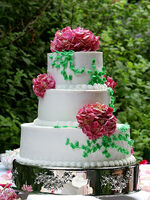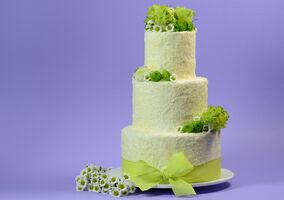Italian Wedding Cakes: A Quick Primer
So, you're planning your wedding in Lucca and all is going well. You've chosen your flowers, the venue, photographer, the music and now it's time for the really fun part, the cake! If you are looking to offer your guests a typically Italian wedding cake, your planner will likely propose three types of cakes for you to choose from, a crostata di frutta, millefoglie, or a pan di spagna. Here is what you need to know about each when you go to your tasting:

Just underneath the beautiful fruit is a pastry cream or chantilly cream filling and supporting the entire cake is a crust that tastes a lot like animal cracker cookies. The crust is quite firm, and depending on the bakery, the bottom can be coated with melted dark chocolate. Some bakeries do a thick crust, which I personally find difficult to cut into at cake cutting time, others produce a thinner, softer crust. This type of cake looks great displayed on a cake stand that is built in tiers from smallest at top to largest at the bottom, see the photo for an idea. It is a good cake to have if your meal is going to be particularly filling as it is a very light dessert that does not weigh you down. Although delicious at any time of the year, it is especially suited to a Summer wedding.
An important thing to note about sponge cake is that it is really easy to cut, can be made into the classic American multi tier cake, and it keeps very well after its been made. You can finish the exterior in whipping cream, or fondant. Many Italians like to cover the sides with finely chopped hazelnuts or almonds.
Know your fillings and finishings
- Crema Pasticcera: "Pastry Cream" also known as vanilla custard cream, is the filling you find in eclairs, cream puffs, and cream pies. Italian bakers use it copiously to fill the crostata di frutta as well as standard filler of mille feuille and sponge cake. It is yellow in color and has of course a lot of egg yolks in it, so can be quite rich. Mixes really well when you put a layer of sliced strawberries on top.
- Crema Chantilly: This is also known in some parts of Italy as,"Crema Diplomatico", but in Lucca you can stick with Crema Chantilly and they'll know what you are talking about. Beware, it is not just Chantilly Cream like you know it with the vanilla flavor and powdered sugar. Rather, in Italy, it is what is produced when you mix pastry cream with whipping cream. The result varies widely as some bakers prefer there to be more whipping cream to pastry cream while others like there to be more pastry cream to whipping cream. If you want to keep it tasting light, try to go for 70% whipping cream to 30% pastry cream. Crema Chantilly is everywhere as a filling and is a popular substitute to plain pastry cream. Sometimes I've had it aromatized with orange flower, and I've found that to be absolutely divine.
- Cioccolato: Often is done as a chocolate mousse and used as a filling for millefoglie that alternates between whipping cream or pastry cream one layer and chocolate mouse another. Can also be done with sponge cake. A variation of this is the same kind of mouse, but hazelnut "nocciola" flavored.
- Panna; "Whipping Cream". Here it is liberally used both as an outside decoration as well as a filling. Some people prefer to have a layer of whipping cream and fruit as a layer for the millefoglie or sponge cake.
- Fondante: Yes, that's Italian for Fondant. Pretty easy to translate this one. While I think it works well with yellow cakes in the English and American tradition, personally, I'm not sure I would recommend fondant over an Italian cake as I find it makes the whole confection a bit too sweet. That said, esthetically speaking, it is very beautiful and does work exceptionally well if you want to have the multi tiered cake.
- Glassata: This refers to a sugar glaze that is made when you mix water, lemon juice and powdered sugar. Can be used to finish the top of the cake with swirls of white and chocolate.
- Zucchero a velo: Powdered sugar. This often is used sprinkled on top of the fruit in the crostata di frutta or if the millefoglie has fruit on it, they will sprinkle it there as well.



Form
The American/British multi tiered cake that shows up in all the brides magazines is a recent addition to the Italian baker's repertoire. You should know that if you want the cake to look this way, the baker can do this for you, but it requires a bit of slight of hand. As all of the traditional Italian cakes are actually quite low, perhaps measuring no more than 6 or 7 cm high, in order to achieve the height of the multi tiers, they use styrofoam as the base, then place the actual cake on top of the styrofoam, then finish the entire confection with fondant or whipping cream so that the part that is styrofoam looks like its part of the cake. Keep this in mind when it comes time to cut the cake. Don't expect the knife to go all the way down, once you hit the 6 cm mark, you're done.
Timing
Try to get your baker to tell you exactly what time of day they plan to make your cake for. If its a millefoglie, you want it made two hours prior to the event, no later or it looses its crispiness. If its a sponge cake its o.k. to have it made that morning, preferably the later the better. Also, you want to have the bakery promise to deliver the cake to your venue in a refrigerator car. Make certain that the people at the venue have a refrigerator big enough to store your cake if it will be sitting for a long time before cutting. The best thing to do is secure a super late delivery time from your baker so you don't have to worry about sitting around and possibly loosing its shape or freshness. Some bakeries in Lucca will deliver as late as 8 p.m., so do make sure you ask. It's worth it.
* photos cakes by Angolo Dolce courtesy of Sandra Bianchi, Angolo Dolce - Lucca
[Lucca Wedding Tips] [permalink]




